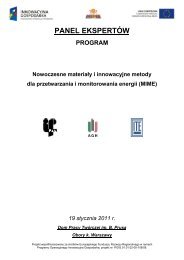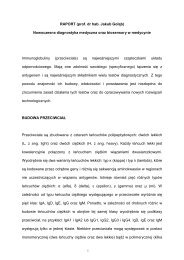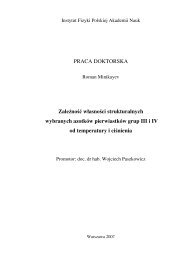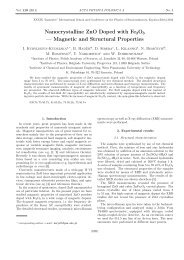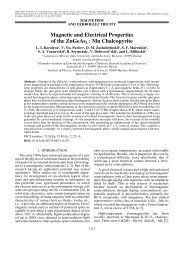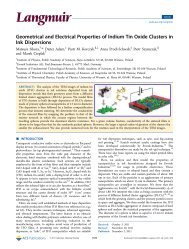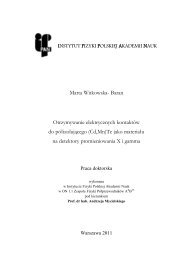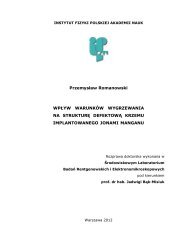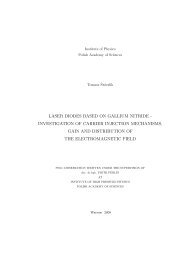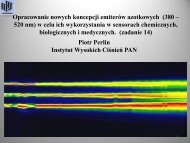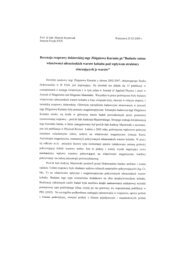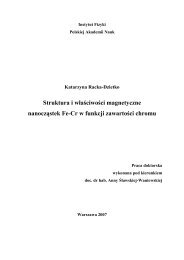Spin waves and the anomalous Hall effect in ferromagnetic (Ga,Mn)As
Spin waves and the anomalous Hall effect in ferromagnetic (Ga,Mn)As
Spin waves and the anomalous Hall effect in ferromagnetic (Ga,Mn)As
Create successful ePaper yourself
Turn your PDF publications into a flip-book with our unique Google optimized e-Paper software.
BMPs to overlap at sufficiently low temperatures <strong>and</strong> giv<strong>in</strong>g rise to a <strong>ferromagnetic</strong>exchange <strong>in</strong>teraction between percolated polarons (Fig. 4.4). If<strong>the</strong> hole localisation radius is significantly lower than <strong>the</strong> distance between<strong>the</strong>m, disorder <strong>effect</strong>s are of crucial importance for <strong>the</strong> magnetic propertiesof <strong>the</strong> material [129].Figure 4.4: Bound magnetic polaron. Holes hop among <strong>Mn</strong> centres (red arrows)<strong>and</strong> align <strong>the</strong>ir d shell sp<strong>in</strong>s via <strong>the</strong> exchange <strong>in</strong>teraction. The percolated BMPs(blue circles) can connect <strong>in</strong>to <strong>ferromagnetic</strong> clusters.Some <strong>the</strong>oretical works, like <strong>the</strong> donor impurity b<strong>and</strong> model, tried toapply this picture to <strong>the</strong> regime where <strong>the</strong> density of localised holes is muchsmaller than <strong>the</strong> density of <strong>Mn</strong> ions [130]. To <strong>the</strong> best of my knowledge,this model did not f<strong>in</strong>d unequivocal confirmation by <strong>the</strong> experimental data.4.3 Magnetic regimes <strong>in</strong> (<strong>Ga</strong>,<strong>Mn</strong>)<strong>As</strong>The character of long-range magnetic order <strong>in</strong> (<strong>Ga</strong>,<strong>Mn</strong>)<strong>As</strong> depends stronglyon <strong>the</strong> <strong>in</strong>terplay of all <strong>the</strong> types of direct <strong>and</strong> <strong>in</strong>direct exchange <strong>in</strong>teractionsdist<strong>in</strong>guished <strong>in</strong> <strong>the</strong> previous section. <strong>As</strong> it has been already mentioned,<strong>the</strong>ir relative prom<strong>in</strong>ence depends on such crucial sample parameters as <strong>the</strong>carrier <strong>and</strong> magnetic moment concentrations. Additionally, <strong>the</strong> number of<strong>Mn</strong> moments <strong>and</strong> (or) holes participat<strong>in</strong>g <strong>in</strong> <strong>the</strong> ordered state may changesignificantly <strong>in</strong> presence of charge <strong>and</strong> moment-compensat<strong>in</strong>g defects.The follow<strong>in</strong>g qualitative picture of different magnetic regimes <strong>in</strong> <strong>the</strong>(<strong>Ga</strong>,<strong>Mn</strong>)<strong>As</strong> dilute magnetic semiconductor emerges from <strong>the</strong> experimentaldata <strong>and</strong> <strong>the</strong>ir <strong>the</strong>oretical <strong>in</strong>terpretations discussed above:• At very low dop<strong>in</strong>g levels, <strong>the</strong> average distance r between <strong>Mn</strong> impurities(or between holes bound to <strong>Mn</strong> ions) is much larger than <strong>the</strong>size of <strong>the</strong> bound hole approximately given by <strong>the</strong> impurity <strong>effect</strong>ive42



